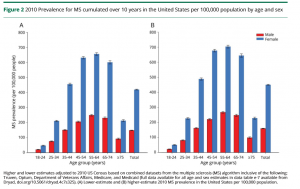Rising Prevalence
For 2010, the cumulated 10-year prevalence was 309.2 per 100,000 or 450.1 per 100,000 for women and 159.7 per 100,000 for men, demonstrating “a steady rise in the prevalence of MS over the past five decades,” according to the authors.
That rise has been quite substantial. A 1976 prevalence study found a rate of 58 per 100,000 and the National Health Interview Survey pegged the rate at 85 per 100,000 from 199 to 1994. Using more restrictive criteria, another study put the rate at 149 per 100,000 for the 2008 to 2012 period.
The divergence in rates between women and men has also increased sharply.
“The trends have been consistent in many places around the world,” Wallin noted, “with rising prevalence and incidence in women. The ratio was close to 1 to 1 in the World War I generation.” In 1976, women were 1.7 times more likely to develop the disease. In the current study, the ratio is 2.8 to 1.
“We don’t have a great explanation” for the increasing rate in women, Wallin added. “It’s probably too quick to be genetics in 50 years. It’s probably things in the environment that women were not exposed to in earlier generations. It might be a virus that they are exposed to as adolescents.”
Those factors might explain the north-south differential in MS prevalence seen in the current and previous studies in the U.S. and across the world. “MS is a disease of geography,” Wallin said. “It could be an environmental thing going on or maybe a virus spreads more readily when people are together in closed environments.”
Wallin and colleagues expanded on the possible triggers for MS in a global study published recently in The Lance Neurology. While more than 200 alleles have been implicated in the disease, the rapid rise in incidence (globally) and prevalence support environmental factors, they observed. “Prime candidates include infection, such as with the Epstein-Barr virus or other organisms, as the initiator of multiple sclerosis, with the suggestion that infections start in the gut and spread to the [central nervous system].”2
Other risk factors might include lack of sunlight or vitamin D, diet, obesity, changes in the gut microbiome, they said.
Continue Reading:


